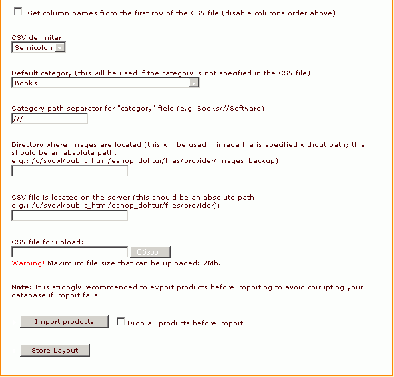X-Cart:Importing products (X-Cart v.3.5.x-4.0.x)
X-Cart allows manual adding of products and defining each and every parameter for any entry in the product list. However, in many cases such maintenance of your catalog in its actual state often turns into a very complicated task, if not an impossible one. Imagine you'd like to offer hundreds, thousands or even more products to your visitors with some parameters (such as, for example, quantity or availability) changing daily or weekly. There are lots of e-shops having separate product database stored on a local workstation or in Intranet and usually incompatible with the common formats of World Wide Web databases. Anyway, in most situations this problem can be solved by importing the long list of items from a large file in a special format (CSV) that can be retrieved by exporting your data from any popular database or a spreadsheet processor.
CSV file format
CSV is an abbreviation for Comma Separated Values, but it can use comma, tab or semicolon as a delimiter to separate values in a plain text file. Columns of data are separated by a delimiter (comma, tab or semicolon), and each row of data ends with a carriage return.
CSV file format is supported by most of grid calculators like Microsoft Excel, Lotus 1-2-3, Quattro Pro etc. You can import products into X-Cart store using CSV format lists. Thus you can keep shop information up to date by importing product list files instead of updating information through the web interface. Large imports can take some time, so please be patient.
As for Microsoft Excel, the most popular software for spreadsheet processing, the CSV saves only the text and values as they are displayed in cells of the active worksheet. All rows and all characters in each cell are saved. Columns of data are separated by commas, and each row of data ends with a carriage return. If a cell contains a comma, the cell contents are enclosed in double quotation marks.
If cells display formulas instead of formula values, the formulas are converted as text. All formatting, graphics, objects, and other worksheet contents are lost.
If your workbook contains special font characters such as a copyright symbol (©), and you will be using the converted text file on a computer with a different operating system, save the workbook in the text file format appropriate for that system. For example, if you are using Windows and want to use the text file on a Macintosh computer, save the file in the CSV (Macintosh) format. If you are using a Macintosh computer and want to use the text file on a system running Microsoft Windows, save the file in the CSV (Windows) format.
Importing a list of products
1. First of all, click on 'Import products' item in the Products menu. The 'Import products' form will appear on the screen.
Picture 1: 'Import products' form
2. Set the columns order. It must be the same as the order used in the CSV file you are going to import.
You do not have to supply values for all the fields (to do this, just place a double delimiter (;;) instead of entering the value between two delimiters (;value;)). However, filling out price, product, descr and avail fields is mandatory as they are required for the application to work correctly. If you are planning to use the "UPDATE INVENTORY" function for further quantity or price updating it's necessary to define product_code as updates are done only by the field product_code.
- productid - Product id
- 'productcode' (recommended) - Product code or SKU.
- 'product' (required) - Product name.
- distribution - Product distribution (for EGoods)
- weight - Product weight
- list_price - List price
- 'descr' (required) - Description
- fulldescr - Detailed description
- 'avail' (required) - Quantity in stock (items)
- forsale - Available for sale (Y or N)
- 'shipping_freight - Shipping freight
- free_shipping - Free shipping (Y or N)
- 'discount_avail' - Apply global discounts (Y or N)
- 'min_amount - Min order amount
- dim_x - x dimension of the product package (for shipping)
- dim_y - y dimension of the product package (for shipping)
- dim_z - z dimension of the product package (for shipping)
- low_avail_limit - Low limit in stock
- free_tax - Non-taxable (Y or N)
- 'product_type - Product type
- manufacturerid - Manufacturer id
- return_time - Time during which the product can be returned to the store
- category - Product category
- 'price' (required) - Price of the product
- thumbnail - Thumbnail image file name and (if necessary) file location
- product_options - Product options
- extra_fields - Extra fields
- manufacturer - Product manufacturer
- applied_taxes - Taxes applied to the product
3. Select the delimiter used in the CSV file you are going to import (comma, tab or semicolon).
4. Select the default category from the drop-down list. If the value of the category field is not specified in the CSV file, the default category will be applied.
5. Enter the category path separator for "category" field (e.g. Books///Software).
6. If you have thumbnails for your products, you should put them all into one directory and specify the absolute path to this directory in the field "Directory".
7. Do one of the following:
- Enter the location of the CSV file if you have uploaded it before, or - Click on 'Browse' and select the necessary CSV file.
8. Click on 'Import products'.
If you want to drop all existing products in your store before you import new products, select the 'Drop all products' before import check box. Be careful, this operation cannot be undone and all existing data in the product catalogue will be lost.

